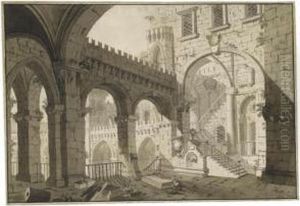Giovanni Maria Quaglio Paintings
Giovanni Maria Quaglio was a prominent member of the Quaglio family of Italian artists, a dynasty known for their contributions to architecture, stage design, and painting over multiple generations. Born in 1780 in Laino, a town in the Duchy of Milan (which is now part of modern-day Italy), Giovanni Maria became part of a long-standing artistic tradition that the Quaglio family upheld.
Giovanni Maria was particularly recognized for his work in scenography and architecture painting. He was trained in the family tradition by his father, Giuseppe Quaglio, who was also an accomplished painter and stage designer. Giovanni Maria's work was influenced by the Romantic sensibilities of his time, as well as the neoclassical style. His architectural paintings often featured dramatic perspectives and were imbued with a romantic atmosphere, emphasizing the grandeur and decay of historical buildings.
Quaglio's career was marked by a series of important commissions and collaborations. He worked extensively on theater designs and decoration, contributing to the visual splendor of operatic and dramatic productions of his day. His talent in stage design was not only appreciated in his native Italy but also in other parts of Europe, particularly in Germany, where he worked for a significant part of his career.
Giovanni Maria Quaglio was also active in Munich, where he became associated with the group of German artists known as the Nazarenes. These artists sought to revive the spirituality and sincerity they admired in medieval and early Renaissance art. While in Munich, Quaglio contributed to the decoration of several buildings, including the famous Residenz Theater.
He died in 1837, leaving behind a rich legacy that continued through his descendants, as the Quaglio artistic lineage persisted well into the 20th century. His works remain a testament to the fusion of Italian artistic tradition with the broader European Romantic movement, and they can be found in various collections and museums across Europe.
